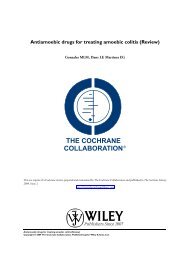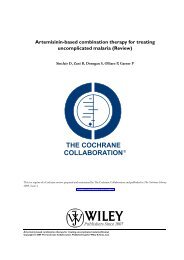Topical treatments for fungal infections of the skin and nails of the foot.
Topical treatments for fungal infections of the skin and nails of the foot.
Topical treatments for fungal infections of the skin and nails of the foot.
You also want an ePaper? Increase the reach of your titles
YUMPU automatically turns print PDFs into web optimized ePapers that Google loves.
The trial <strong>of</strong> oxiconazole (n = 155, Ellis 1989) had an observed<br />
relative reduction in treatment failure at 2 weeks <strong>of</strong> 21% (RR<br />
0.79, 95% CI 0.61 to 1.02; Analysis 2.1) which was not quite<br />
statistically significant. Overall <strong>the</strong> pooled estimated relative risk<br />
<strong>of</strong> treatment failure (n = 329, 5 trials) <strong>of</strong> 1% azoles (bifonazole<br />
or oxiconazole) versus placebo at 2 weeks was 41% (RR 0.59,<br />
95% CI 0.43 to 0.82; Analysis 2.1), though <strong>the</strong>re was considerable<br />
variation between <strong>the</strong> results <strong>for</strong> <strong>the</strong> 2 different azoles (overall I 2<br />
= 50%).<br />
Medium-term outcome (six weeks)<br />
All azoles versus placebo<br />
There was statistically significant evidence <strong>of</strong> effectiveness <strong>for</strong> each<br />
<strong>of</strong> <strong>the</strong> azoles individually except miconazole nitrate, which was<br />
studied in only 54 people, providing inconclusive results (RR <strong>of</strong><br />
treatment failure 0.41, 95% CI 0.14 to 1.14; Analysis 2.2) (Gentles<br />
1974; M<strong>and</strong>y 1974). The results were generally fairly consistent<br />
both between individual studies <strong>for</strong> each azole, <strong>and</strong> between different<br />
azoles. Overall, a meta-analysis <strong>of</strong> data from 13 trials (n<br />
= 1235, Akers 1989; Bagatell 1986; C<strong>of</strong>fey 1986; Elewski 1996;<br />
Ellis 1989; Izuno 1986; Gentles 1974; M<strong>and</strong>y 1974; Smith 1977;<br />
Smith 1986; Smith 1988a; Spiekermann 1976a; Spiekermann<br />
1976b) comparing azoles with placebo estimated <strong>the</strong> pooled relative<br />
reduction in treatment failure as 60% (RR 0.40, 95% CI 0.35<br />
to 0.46; Analysis 2.2).<br />
Sensitivity analysis<br />
<strong>Topical</strong> <strong>treatments</strong> <strong>for</strong> <strong>fungal</strong> <strong>infections</strong> <strong>of</strong> <strong>the</strong> <strong>skin</strong> <strong>and</strong> <strong>nails</strong> <strong>of</strong> <strong>the</strong> <strong>foot</strong>. (Review)<br />
Copyright © 2009 The Cochrane Collaboration. Published by John Wiley & Sons, Ltd.<br />
A sensitivity analysis based only on data collected in <strong>the</strong> 6 trials<br />
with at least 80% follow up at 6 weeks (n = 448, Akers 1989; Ellis<br />
1989; Gentles 1974; M<strong>and</strong>y 1974; Smith 1977; Smith 1988a)<br />
showed very similar results (RR <strong>of</strong> treatment failure 0.43 (95% CI<br />
0.34 to 0.53; Analysis 2.3).<br />
A L’Abbé plot <strong>of</strong> <strong>the</strong> outcomes at 6 weeks (Figure 2) demonstrates<br />
that <strong>the</strong> azoles generally had treatment failure rates <strong>of</strong> around<br />
25%, compared to around 50 to 90% <strong>for</strong> placebos (see Methods,<br />
statistical analysis <strong>for</strong> more details <strong>of</strong> L’Abbé plots <strong>and</strong> how to<br />
interpret <strong>the</strong>m).<br />
9








